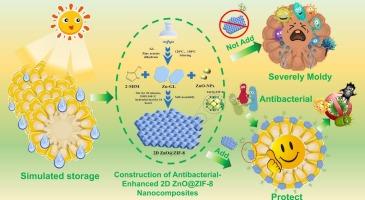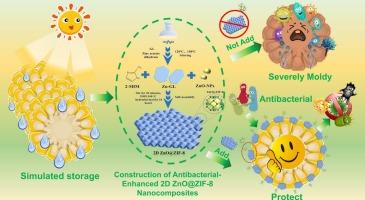Construction of antibacterial-enhanced 2D ZnO@ZIF-8 nanocomposites based on synergistic antimicrobial mechanisms and application in maize long-term storage
IF 9.8
1区 农林科学
Q1 CHEMISTRY, APPLIED
引用次数: 0
Abstract
The prevention of bacterial growth and mold during the long-term storage of maize is a long-standing concern. This study introduced a synergistic antibacterial enhanced ZnO nanocomposite prepared by a top-down template method based on self-assembly mechanism. The results showed that 2D ZnO@ZIF-8 nanocomposites, with uniform ZnO encapsulation in dodecahedral ZIF-8 frameworks, exhibiting high surface area and microporous structure. The nanocomposites demonstrated synergistic antibacterial effects through sheet morphology, multi-site activity, and ROS generation, the inhibition rates against Staphylococcus aureus, Escherichia coli, Aspergillus flavus, Aspergillus niger, and Penicillium citrinum were increased by 20.65 %, 38.87 %, 39.91 %, 38.55 %, and 40.34 %, respectively, compared with ZnO. During 42-day simulation storage, it reduced maize surface microbes by 99.5 %, while maintaining safe Zn2+ levels. The treatment suppressed toxigenic fungi, Fusarium, Meyerozyma, Penicillium, and effectively controlled A. flavus without altering species richness. This work presented an ideal ZnO-based antibacterial nanomaterial for long-term safe storage of maize.


基于协同抗菌机制的二维ZnO@ZIF-8纳米复合材料的构建及其在玉米长期储存中的应用
在玉米的长期储存过程中,防止细菌生长和霉菌是一个长期关注的问题。本研究介绍了一种基于自组装机制的自顶向下模板法制备的协同抗菌增强ZnO纳米复合材料。结果表明,在十二面体ZIF-8框架中均匀包裹ZnO的二维ZnO@ZIF-8纳米复合材料具有高比表面积和微孔结构。纳米复合材料通过形貌、多位点活性和活性氧生成等方面表现出协同抑菌作用,对金黄色葡萄球菌、大肠杆菌、黄曲霉、黑曲霉和柑橘青霉的抑菌率分别比ZnO提高20.65 %、38.87 %、39.91 %、38.55 %和40.34 %。在42天的模拟贮藏期间,玉米表面微生物减少99.5% %,同时保持安全的Zn2+水平。在不改变菌种丰富度的情况下,对产毒真菌、镰刀菌、Meyerozyma、青霉菌均有抑制作用。本工作提出了一种理想的玉米长期安全储存的zno基抗菌纳米材料。
本文章由计算机程序翻译,如有差异,请以英文原文为准。
求助全文
约1分钟内获得全文
求助全文
来源期刊

Food Chemistry
工程技术-食品科技
CiteScore
16.30
自引率
10.20%
发文量
3130
审稿时长
122 days
期刊介绍:
Food Chemistry publishes original research papers dealing with the advancement of the chemistry and biochemistry of foods or the analytical methods/ approach used. All papers should focus on the novelty of the research carried out.
 求助内容:
求助内容: 应助结果提醒方式:
应助结果提醒方式:


